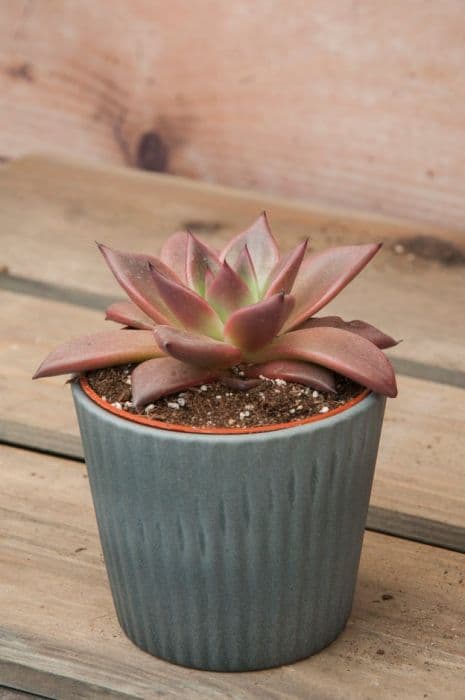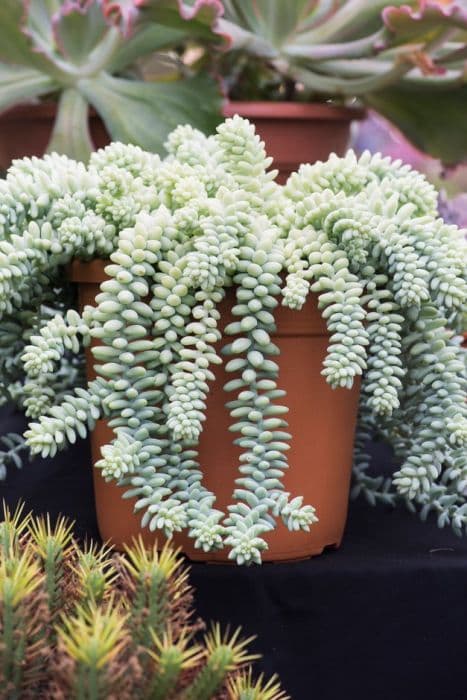Mexican Firecracker Echeveria setosa

ABOUT
Echeveria setosa, commonly known as the Mexican Firecracker, is a strikingly attractive succulent that boasts a rosette of thick, fleshy leaves. These leaves are usually a light green hue and have a characteristic velvety appearance due to the fine white hairs that cover them, giving the plant a soft, fuzzy texture. The distinctive hairiness of the leaves serves as a distinguishing feature of this species. The plant's overall shape is compact and symmetrical, with the leaves arranged in a spiral fashion that emanates outwards from the center. The tips of the leaves may be tinged with a reddish or pinkish color, which adds a delicate blush to the lush green rosette. During its blooming period, the Mexican Firecracker produces bright red to orange, bell-shaped flowers that rise above the foliage on slender, arching stems, contrasting vividly with the green and white of the leaves. These vibrant flowers are particularly attractive to hummingbirds and can add a splash of color to the plant's overall appearance. The combination of its soft, downy leaves and the bold, fiery flowers creates a visually stunning display that is characteristic of the Mexican Firecracker.
About this plant
 Names
NamesFamily
Crassulaceae.
Synonyms
Mexican Firecracker, Firecracker Plant, Firecracker Echeveria, Fuzzy Hen and Chicks.
Common names
Echeveria setosa var. ciliata, Echeveria setosa var. deminuta, Echeveria setosa var. minor, Echeveria setosa var. setosa, Urbinia setosa.
 Toxicity
ToxicityTo humans
The Firecracker plant (Echeveria setosa) is generally considered non-toxic to humans. There are no significant toxic effects reported for ingestion of this plant, which means it is unlikely to cause harm if accidentally consumed in small quantities.
To pets
Similarly, for pets, the Firecracker plant is non-toxic. It is safe around cats, dogs, and other household pets, with no adverse effects expected if they ingest parts of the plant.
 Characteristics
CharacteristicsLife cycle
Perennials
Foliage type
Evergreen
Color of leaves
Green
Flower color
Red
Height
5 inches (12.7 cm)
Spread
5 inches (12.7 cm)
Plant type
Succulent
Hardiness zones
9
Native area
Mexico
Benefits
 General Benefits
General Benefits- Low Maintenance: Echeveria setosa, also known as Mexican Firecracker, requires minimal care, making it ideal for busy or novice gardeners.
- Drought Tolerant: This plant is able to withstand periods without water due to its succulent nature, which is perfect for xeriscaping or dry climates.
- Aesthetic Appeal: With its rosette shape and furry appearance, it adds unique texture and interest to gardens or as a houseplant.
- Propagation Ease: It is relatively easy to propagate from leaves or offsets, allowing gardeners to expand their collection or share with others.
- Pest Resistant: Mexican Firecracker has few problems with pests, partially because of the hairy texture of its leaves, which deters many pests.
- Seasonal Interest: It produces bright red and yellow flowers that add a pop of color to the plant’s display in the late spring or early summer.
 Medical Properties
Medical PropertiesThis plant is not used for medical purposes.
 Air-purifying Qualities
Air-purifying QualitiesThis plant is not specifically known for air purifying qualities.
 Other Uses
Other Uses- Echeveria setosa, commonly known as Mexican Firecracker, can be used in fairy gardens or miniature scenes due to its small size and unique appearance, which adds a whimsical touch.
- Its rosettes can be a creative addition to bridal bouquets or boutonnieres, offering a succulent flair to wedding arrangements.
- These plants can be used in living wall art or vertical gardens, as their minimal root systems allow them to thrive even in shallow soil and contribute to the aesthetic with their texture.
- The Mexican Firecracker can serve as a natural mulch when its leaves fall off and decompose, providing organic matter to help retain soil moisture.
- Leaf cuttings from Echeveria setosa can be used in DIY craft projects, like creating succulent wreaths or framed succulent art pieces.
- Photographers and artists might utilize the plant as a subject for botanical illustration or still life photography because of its intricate form and vibrant colors.
- This plant can be used in educational settings to teach children or students about propagation, as it easily produces offsets.
- In xeriscaping, Echeveria setosa is valued for its drought tolerance and can be planted in water-conserving gardens to reduce the need for irrigation.
- As a centerpiece in container gardens, it can be surrounded by contrasting foliage plants to highlight its distinct shape and texture.
- The colorful and striking appearance of the Mexican Firecracker makes it an ideal choice for ornamental display in terrariums, especially those with a desert theme.
Interesting Facts
 Feng Shui
Feng ShuiThe Mexican Firecracker is not used in Feng Shui practice.
 Zodiac Sign Compitability
Zodiac Sign CompitabilityThe Mexican Firecracker is not used in astrology practice.
 Plant Symbolism
Plant Symbolism- Resilience: Echeveria setosa, commonly known as Mexican Firecracker, is known for its hardiness and ability to thrive in tough conditions, making it symbolize the capacity to endure and persist.
- Beauty: With its rosette pattern and colorful appearance, the Mexican Firecracker represents beauty and natural aesthetics.
- Self-reliance: As a succulent that requires minimal water and care, this plant embodies independence and the ability to sustain oneself.
- Enduring Love: Due to its perennial nature and long-lasting structures, the Mexican Firecracker is often associated with lasting relationships and enduring affection.
- Protection: The hairy and fuzzy texture of the leaves, which seem to protect the plant from the harsh sun, can symbolize shelter and safety.
 Water
WaterThe Mexican Firecracker should be watered thoroughly when the soil is dry to the touch, approximately every 7 to 14 days, depending on the humidity and temperature conditions—more frequently in hot, dry conditions and less often in cool, humid environments. It is best to use the soak-and-dry method, pouring water directly onto the soil and allowing excess water to drain away, ensuring the roots get enough moisture without the plant sitting in water. Provide enough water so that it runs out of the pot's drainage holes; for a small pot, this might be about 8 to 16 ounces every watering session.
 Light
LightMexican Firecracker thrives in bright, indirect sunlight but can also tolerate direct morning light and partial shade. The ideal spot for this succulent is near a south or east-facing window where it will receive plenty of light without being exposed to the harsh afternoon sun. Avoid placing it in deep shade or low-light areas as this can lead to etiolation and poor growth.
 Temperature
TemperatureThe Mexican Firecracker prefers temperatures ranging from 65 to 80 degrees Fahrenheit but can tolerate a wider range between 40 and 90 degrees Fahrenheit. However, it is not frost-hardy and should be protected from temperatures below 40 degrees Fahrenheit. The ideal temperature range promotes healthy growth and flowering.
 Pruning
PruningPruning the Mexican Firecracker is generally not needed as it maintains its compact structure well. However, if desired for aesthetic reasons or to remove damaged leaves, prune during the spring or early summer to help the plant recover and grow back more vigorously. Trimming off any dead or dying leaves with clean scissors or pruning shears can help maintain the plant's appearance.
 Cleaning
CleaningAs needed
 Soil
SoilThe best soil mix for the Mexican Firecracker is a well-draining cactus or succulent mix, enriched with perlite or pumice for added drainage. This plant prefers a soil pH slightly acidic to neutral, around 6.0 to 7.5.
 Repotting
RepottingThe Mexican Firecracker should be repotted every two to three years or when it outgrows its pot, to refresh the soil and encourage healthy growth.
 Humidity & Misting
Humidity & MistingThe Mexican Firecracker does well in dry air and prefers low humidity levels typical of arid environments.
 Suitable locations
Suitable locationsIndoor
Place in bright, indirect light and avoid overwatering.
Outdoor
Grow in well-draining soil, full to partial sun.
Hardiness zone
9-11 USDA
 Life cycle
Life cycleThe Mexican Firecracker begins its life as a seed, which upon finding suitable conditions, germinates and sprouts into a seedling. As it grows, the young plant develops a rosette of fleshy, hairy leaves characteristic of the species, along with a strong root system. When mature, the Echeveria setosa produces striking red and yellow flowers on tall stalks that attract pollinators, ensuring the plant's reproduction. After pollination, seeds are produced and dispersed, allowing the cycle to continue. Throughout its life, the Mexican Firecracker can also reproduce vegetatively through offsets, which are small clones that grow around the base of the parent plant. These plants are perennial, often living for several years with proper care, and go through seasonal growth cycles, with active growth in the spring and summer, and dormancy in winter.
 Propogation
PropogationPropogation time
Spring-Summer
The Mexican Firecracker, also known as Echeveria setosa, can be effectively propagated from leaf cuttings. The ideal time for propagation is in the spring or early summer when the plant is actively growing. To propagate, a healthy, plump leaf should be gently twisted from the stem, ensuring that the entire leaf base is intact. The leaf cutting should then be left to dry for a day or two until the cut end callouses over to prevent rot. After that, the leaf can be placed on top of a well-draining soil mix, slightly pressing it into the surface. The soil should be kept slightly moist by misting it regularly. Roots and a new rosette will usually begin to develop within a few weeks. For best results, it's important to provide bright, indirect light and avoid overwatering to prevent decay.









![Takeshima stonecrop [Atlantis]](/_next/image?url=https%3A%2F%2Fplants-admin.emdemapps.com%2Fimages%2Fplants%2F%2Fimages%2F604b5470cdde2.png&w=640&q=75)